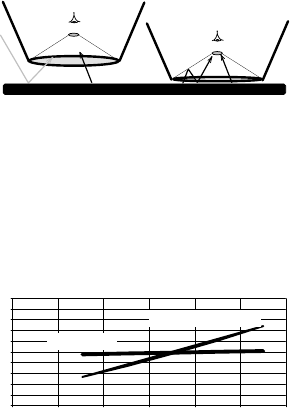
Correcting for Emissivity Automatically
Biological tissue has
high emissivity, i.e.
~0.95. Accordingly,
the reflected compo-
nent will be about 5%
of the energy mea-
sured by the
DermaTemp, which
translates to an abso-
lute error of ~1°F
(0.5°C). In addition, skin emissivity varies due to color, texture, etc.
over the approximate range of 0.92 to 0.98. An uncertainty of approxi-
mately ±1°F (0.5°C) results from this emissivity variation, which can
appreciably influence the assessment of a subtle perfusion issue.
A more significant er-
ror is due to the re-
flected energy, which
can vary considerably
if the ambient radiation
includes sunlight, radi-
ant warmers, etc. To
solve this problem the
DermaTemp is
equipped with a unique
patented feature called
Automatic Emissivity
Compensation System
(AECS). The reflective
cup on the end of the probe automatically compensates for emissivity
when it is touching, or brought to within approximately 1mm of the sur-
face. By excluding ambient radiation, and replacing it with reflections
of emitted radiation, the emissivity is corrected, and the accurate tem-
perature indicated
Detection by Exception
The distribution of the temperature on the body surface varies appre-
ciably. For example, on a normal individual, the highest average skin
temperature is the forehead at 34.5°C (±0.73°C) and the lowest aver-
age temperature is the toes at 27.1°C (±2.72°C).
1
Considering the
temperature of the skin is highly influenced by ambient temperature,
one could wonder what diagnostic role, if any, temperature would play.
The answer is that it plays a significant role, and the reason is the
N
o
AECS
AECS active
When AECS is active, ambient radiation is excluded
and replaced by reflections of emitted radiation.
Ambient T (F)
90
94
98
102
106
110
0 20 40 60 80 100 120
Conventional Infrared
DermaTemp
38
43
32
4 162738
d
e
g
F
deg C
Effect of ambient temperature on infrared device
readings for a surface at 38ºC (100ºF) with
emissivity 0.9.
18


















